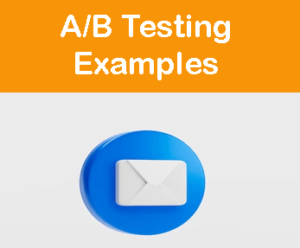What's Inside?
A/B testing is a valuable technique for email marketers to increase open rates, click-through rates, and overall conversion rates. The basic idea of A/B testing in email marketing is to create two versions of an email and send them to a randomly selected subset of your email list. The emails will differ by a single element, such as the subject line, the sender name, the content, or the call-to-action.
After the test emails have been sent, the email marketing software will collect data on how each email performed, such as the number of opens, clicks, and conversions. Based on the results, you can determine which version of the email was more successful and send that version to the rest of your email list.
When conducting A/B tests in email marketing, it’s important to test one variable at a time, so you can be sure which change led to the improvement in performance. Some of the elements that can be tested in an email include the subject line, preheader text, sender name, email content, images, and calls to action.
To ensure accurate and reliable results, it’s also essential to test with a large enough sample size and over a sufficient period. It’s recommended to test with a sample size of at least 1,000 subscribers and to run the test for at least 48 hours.
Top Elements to Test Using A/B Testing
A/B testing in email marketing allows you to test different elements of your emails to improve their performance. Here are some of the top elements to test:
- Subject Line: Test different subject lines to see which ones have a higher open rate.
- Sender Name: Test different sender names to see which ones are more likely to be trusted by your subscribers.
- Email Content: Test different content formats, such as long-form or short-form content, to see which ones generate more engagement.
- Call-to-Action (CTA): Test different CTAs, such as different wording or button colors, to see which ones drive more clicks.
- Personalization: Test using personalization in your emails, such as adding the recipient’s name or location, to see if it improves engagement.
- Timing: Test sending your emails at different times to see when your subscribers are most likely to engage with them.
- Design: Test different email designs, such as layouts, colors, and images, to see which ones are more visually appealing and generate more clicks.
- Segmentation: Test sending different versions of your emails to different segments of your audience to see which versions perform better for different groups.
By testing these elements, you can gain insights into what resonates best with your subscribers and improve the effectiveness of your email marketing campaigns.
A/B Testing Examples
 Here are a few examples and case studies of successful A/B testing in email marketing:
Here are a few examples and case studies of successful A/B testing in email marketing:
- Subject Line Testing: A company sent out two different versions of the same email, with one version having a straightforward subject line and the other having a more creative and personalized subject line. The personalized subject line resulted in a 17% increase in open rates.
- Call-to-Action (CTA) Testing: A company tested two different CTAs in their email campaign – one with a green button and the other with a red button. The green button resulted in a 21% increase in click-through rates.
- Content Testing: A company tested two versions of their email content, with one version being text-heavy and the other having more visual elements like images and videos. The visual-heavy version resulted in a 65% increase in click-through rates.
- Timing Testing: A company tested the timing of their email campaigns, sending one version in the morning and the other in the afternoon. The afternoon version resulted in a 23% increase in open rates.
- Personalization Testing: A company tested two versions of their email content, with one version using the recipient’s first name in the subject line and body of the email, and the other not using any personalization. The personalized version resulted in a 29% increase in open rates.
A/B testing in email marketing can be a powerful tool to optimize campaigns and improve performance. By testing various elements like subject lines, CTAs, content, timing, and personalization, marketers can gain valuable insights and make data-driven decisions to improve their email campaigns.
A/B Testing Checklist to Get Started
Here’s an A/B testing checklist to get started:
- Identify your goals: Determine what you want to achieve through A/B testing, such as increased open rates, click-through rates, or conversions.
- Determine your sample size: Decide how many subscribers you want to include in your test group, based on the size of your email list and statistical significance.
- Select your variable: Choose the element you want to test, such as subject line, sender name, email content, call-to-action, or email design.
- Create your variants: Develop two or more versions of your email, each with a single change in the variable you selected.
- Test your variants: Randomly divide your sample group into equal parts and send each variant to a different group.
- Monitor your results: Track your open rates, click-through rates, and conversions for each variant and compare them to determine which one performs better.
- Analyze your data: Review the data and statistical significance to determine which variant is the winner.
- Implement the winner: Send the winning variant to the rest of your email list and use the results to optimize future email campaigns.
- Repeat the process: Continuously test different variables and analyze your results to improve your email marketing performance over time.
Remember to only test one variable at a time to get accurate results, and to run tests for a significant period to ensure that your data is reliable.
A/B testing process
 The A/B testing process involves the following steps:
The A/B testing process involves the following steps:
- Identify the goal: Determine the specific metric you want to improve, such as click-through rates, conversions, or revenue.
- Develop a hypothesis: Formulate a hypothesis about what changes could improve the identified metric. For example, changing the call-to-action (CTA) button color or text could increase click-through rates.
- Create variations: Develop two or more versions of the element you want to test, such as two different CTA button colors or texts.
- Determine sample size: Decide on the number of participants you need to ensure statistical significance.
- Assign participants: Randomly assign participants to one of the variations.
- Conduct the test: Run the experiment for a set period, typically one to four weeks.
- Collect data: Collect data on the performance of each variation, such as the number of clicks or conversions.
- Analyze results: Analyze the data to determine which variation performed better in achieving the goal.
- Implement the winner: Implement the variation that performed better and continue testing to further optimize and improve results.
Analytics and A/B testing
Analytics and A/B testing plays a critical role in email marketing by providing insights into the effectiveness of email campaigns and helping marketers make data-driven decisions.
Analytics tools like Google Analytics, Mailchimp, and Campaign Monitor provide metrics such as open rates, click-through rates, conversion rates, and bounce rates, which can be used to assess the performance of an email campaign. These metrics can be compared against industry benchmarks or previous campaign data to identify areas for improvement.
A/B testing can be used to test different elements of an email campaign, such as subject lines, email copy, images, calls-to-action, and layout. By randomly dividing the email list into two groups and sending different versions of an email to each group, marketers can determine which version performs better based on metrics such as open and click-through rates.
The results of A/B testing can inform future email campaigns and improve the effectiveness of email marketing efforts. Marketers can also use the insights gained from analytics and A/B testing to create more targeted and personalized email campaigns, further increasing engagement and conversions.
Metrics for A/B testing
 There are several metrics to consider when conducting A/B testing in email marketing. Here are some of the most important ones:
There are several metrics to consider when conducting A/B testing in email marketing. Here are some of the most important ones:
- Open rate: This is the percentage of recipients who opened your email. It can be a good indicator of how effective your subject line and preheader text are in getting people to open your email.
- Click-through rate (CTR): This measures the percentage of people who clicked on a link in your email. It is a good measure of how well your email content and calls to action are engaging your subscribers.
- Conversion rate: This is the percentage of people who completed a desired action after clicking through from your email, such as making a purchase or filling out a form. It is the ultimate measure of success for your email campaign.
- Bounce rate: This measures the percentage of emails that were undeliverable, either because the email address was invalid or because the recipient’s email server rejected it. A high bounce rate can indicate issues with your email list quality.
- Unsubscribe rate: This measures the percentage of recipients who clicked the unsubscribe link in your email. It can be a good measure of how well you are targeting your emails and providing relevant content.
By tracking these metrics for both the control and test groups in your A/B test, you can determine which version of your email is more effective at driving engagement and conversions.
Understanding A/B testing statistics
A/B testing statistics are essential in analyzing the results of an email marketing campaign. Understanding the statistics can help determine which version of the email performed better and make data-driven decisions for future campaigns.
The most important statistical metric in A/B testing is the confidence level, which measures the probability that the result is not due to chance. Typically, a confidence level of 95% or higher is considered statistically significant in A/B testing. This means that there is a 95% probability that the result of the test is not due to chance.
Another important metric is the conversion rate, which measures the percentage of recipients who took the desired action, such as clicking on a link or making a purchase. By comparing the conversion rates of the two versions of the email, it is possible to determine which version was more effective in achieving the campaign’s goals.
Other metrics that can be used in A/B testing include open rates, click-through rates, bounce rates, and unsubscribe rates. These metrics can provide insight into how well the email resonated with the target audience and can be used to make improvements for future campaigns.
It is important to note that A/B testing statistics are only one piece of the puzzle in evaluating the success of an email marketing campaign. Other factors, such as the size and quality of the email list, the relevance of the content, and the timing of the email, can also impact the results. Therefore, it is important to consider all relevant factors when analyzing the success of an email campaign.
Benefits of A/B testing
A/B testing in email marketing offers several benefits, including:
- Improved engagement: A/B testing helps you identify the email elements that resonate best with your audience, leading to higher open rates, click-through rates, and engagement.
- Better conversion rates: By testing different versions of your email, you can identify the copy, images, and calls-to-action that drive the most conversions.
- Reduced bounce rates: A/B testing helps you identify the email elements that lead to high bounce rates, enabling you to adjust them accordingly.
- Better understanding of your audience: Through A/B testing, you can gain insights into your audience’s preferences, interests, and behaviors, allowing you to tailor your emails to their specific needs.
- Cost-effective: A/B testing is a cost-effective way to optimize your email campaigns since you are testing variations of an existing campaign rather than creating an entirely new one.
- Continuous improvement: A/B testing is an ongoing process that enables you to continuously improve your email campaigns based on data-driven insights.
A/B testing in email marketing can help you create more effective and engaging campaigns, leading to increased ROI and customer satisfaction.
A/B testing challenges
 A/B testing in email marketing can be a powerful tool for improving campaign performance, but it also comes with its own set of challenges. Here are some common challenges that marketers may face when conducting A/B tests in email marketing:
A/B testing in email marketing can be a powerful tool for improving campaign performance, but it also comes with its own set of challenges. Here are some common challenges that marketers may face when conducting A/B tests in email marketing:
- Limited sample size: A/B testing requires a large enough sample size to be statistically significant. With email marketing, the size of the email list can be limited, which can make it challenging to get accurate results.
- Too many variables: It’s important to test only one variable at a time in an A/B test to ensure that the results are reliable. However, in email marketing, there may be many variables to consider, such as subject lines, preheaders, sender name, email content, and call-to-action buttons. It can be difficult to isolate just one variable for testing.
- Time constraints: Conducting A/B tests can be time-consuming, and marketers may not have the luxury of waiting for conclusive results before sending out an email campaign. This can lead to rushed tests or a lack of testing altogether.
- Difficulty in interpreting results: A/B testing results can be difficult to interpret, especially for marketers who may not be familiar with statistical analysis. It can be challenging to determine whether the results are statistically significant or simply due to chance.
- Over-reliance on testing: A/B testing can be a valuable tool, but it should not be the only factor in decision-making. Marketers need to use their judgement and experience to make informed decisions about email campaigns, rather than relying solely on the results of A/B tests.
A/B testing mistakes to avoid
Here are some common A/B testing mistakes to avoid in email marketing:
- Testing too many variables at once: It’s important to focus on one variable at a time to avoid confusion and ensure accurate results.
- Testing with a small sample size: Testing with a small sample size can lead to inaccurate results. Make sure you have a large enough sample size to generate statistically significant results.
- Not testing frequently enough: A/B testing should be a continual process, so it’s important to test frequently to keep up with changes in consumer behavior and preferences.
- Not having a clear hypothesis: It’s important to have a clear hypothesis before starting a test to ensure you’re testing the right variables and have a clear understanding of what you’re trying to achieve.
- Not tracking the right metrics: Make sure you’re tracking the right metrics that align with your goals and objectives. Tracking irrelevant metrics can lead to inaccurate conclusions and ineffective strategies.
- Ignoring qualitative feedback: Quantitative data is important, but qualitative feedback from customers can provide valuable insights that can help improve your A/B testing strategy.
- Not considering the big picture: A/B testing is just one part of a larger marketing strategy. Make sure you’re considering the big picture and how A/B testing fits into your overall marketing goals and objectives.
Are A/B Tests Worth It?
Yes, A/B tests can be very much worth it in many cases. By running A/B tests, you can identify what works best for your audience and optimize your email marketing campaigns accordingly. This can lead to increased engagement, better conversion rates, and ultimately, higher revenue.
However, it’s important to keep in mind that A/B testing requires careful planning, execution, and analysis. It can be time-consuming and resource-intensive. Additionally, A/B tests should be conducted on a large enough sample size to ensure that the results are statistically significant.
The decision to conduct A/B tests should be based on your specific business goals and audience. If you have a large enough email list and want to optimize your email marketing efforts, A/B testing can be a valuable tool to help you achieve your objectives.
Tips to improve your A/B testing program
Here are some tips to improve your A/B testing program in email marketing:
- Clearly define your goals: Before starting any A/B test, clearly define the goals you want to achieve. This will help you design the test in a way that will help you reach those goals.
- Test one variable at a time: Testing multiple variables at once can make it difficult to determine which element was responsible for any changes in the results. Therefore, it’s better to test one variable at a time.
- Use a large enough sample size: Your sample size should be large enough to ensure that the results are statistically significant. Use statistical significance calculators to determine the required sample size.
- Avoid bias: Try to avoid any bias that may affect the results of the test. This includes things like sending one version of the email to a certain group of people, or using different language in the two versions of the email.
- Use automation tools: Use automation tools to make the process of setting up and running A/B tests easier. This can help you run more tests and get better results.
- Analyze the results: Analyze the results of each A/B test to determine what worked and what didn’t. Use this information to improve future campaigns and tests.
- Keep testing: A/B testing should be an ongoing process. Keep testing and optimizing your campaigns to get the best possible results.
Segmenting A/B tests
 Segmenting A/B tests in email marketing involves dividing your email list into specific groups based on different criteria such as demographics, behavior, location, etc. This allows you to test different versions of your email to each segment, rather than to your entire email list.
Segmenting A/B tests in email marketing involves dividing your email list into specific groups based on different criteria such as demographics, behavior, location, etc. This allows you to test different versions of your email to each segment, rather than to your entire email list.
Segmenting your A/B tests can provide more accurate and actionable results, as it allows you to see how different versions of your email perform with specific groups of your audience. For example, if you want to test the effectiveness of a promotional email for a new product launch, you can segment your list based on customers who have previously purchased a similar product, customers who have expressed interest in the product, or customers who live in a specific geographic location.
Segmentation also enables you to tailor your email content to specific groups, which can increase engagement and conversion rates. By sending targeted and relevant emails, you can establish a deeper connection with your audience and encourage them to take action.
When segmenting your A/B tests, it is essential to ensure that your segments are large enough to provide reliable results. You should also consider the potential overlap between your segments and avoid testing too many variations at once, as this can dilute the impact of your results.
Segmenting your A/B tests in email marketing can be an effective way to improve the accuracy and relevance of your tests, leading to more significant insights and better results for your email campaigns.


